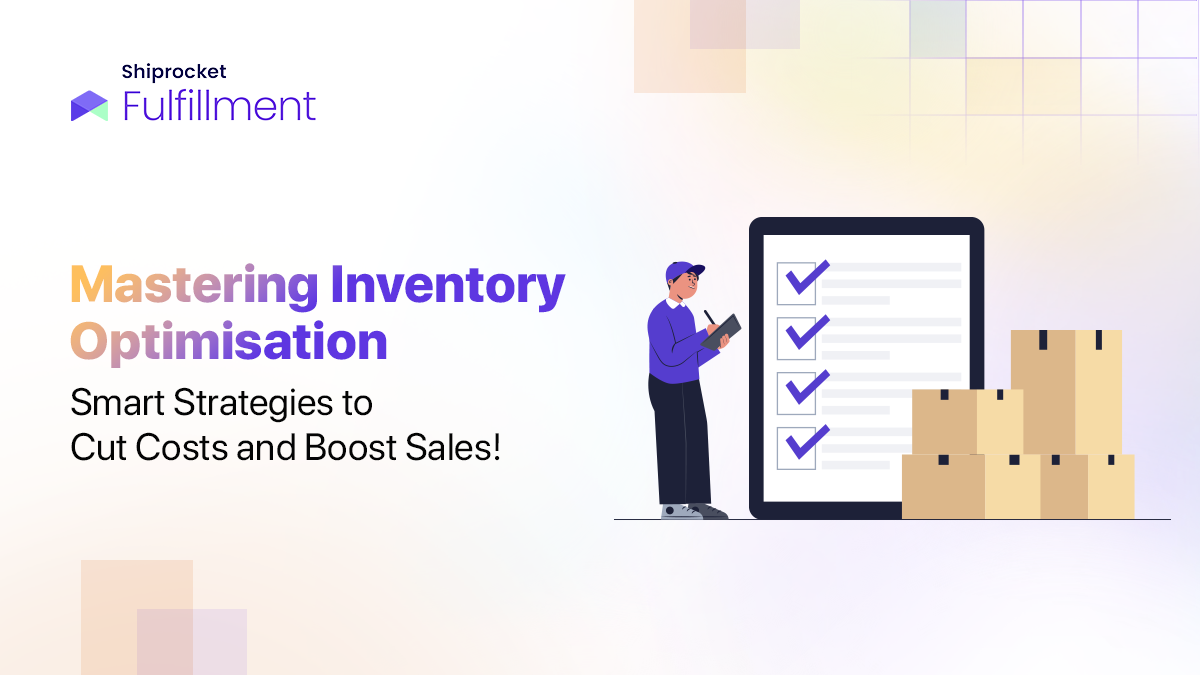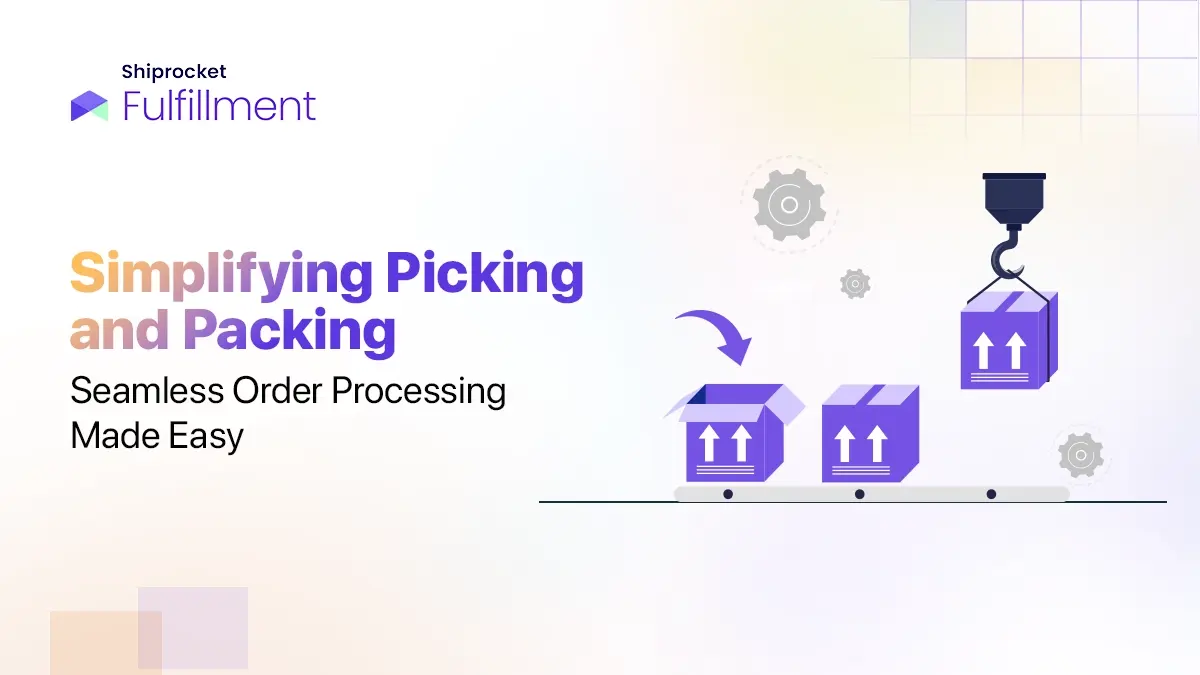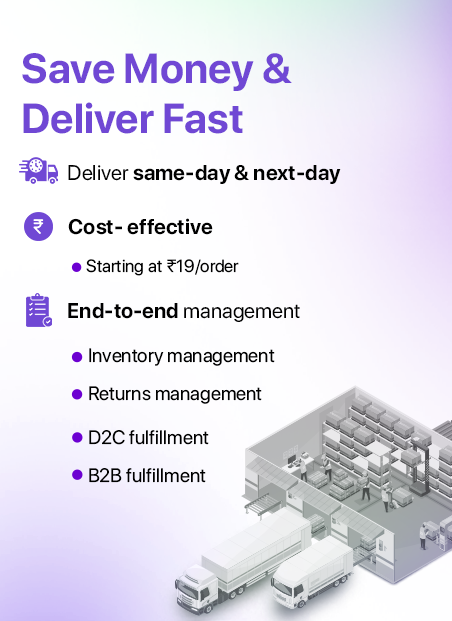- What is Putaway in Warehouse Operations
- Why Optimising Putaway Can Improve Overall Efficiency
- Exploring Putaway Methods Used in Warehousing
- Best Practices to Improve Your Putaway Operations
- Variables That Influence Putaway Efficiency
- KPIs for Warehouse Putaway Success
- Why Brands Trust Shiprocket Fulfillment for Faster & Smarter Putaway
- Conclusion
Did you know 45% of warehouse managers report serious inefficiencies in their putaway workflows? In addition to replenishment and inventory control, warehouse putaway remains one of the most problematic areas in warehouse operations.
17% of businesses specifically point out putaway as a major challenge impacting their performance. Warehouse putaway processes can have a significant operational impact, as they directly affect picking speed, inventory accuracy, and overall throughput. If items aren’t stored in the right place at the right time, it can result in slower fulfillment rates, higher error chances, and increased operational costs.
This blog explores the various types of warehouse putaway methods, the steps in the process, key performance indicators to track for improvement, best practices, and more.
What is Putaway in Warehouse Operations
Putaway is the step in warehouse operations where items are moved from the area where they were received, such as a dock or receiving station, to the location where they will be stored in the warehouse. It’s a planned and organised process, and goods are not moved randomly.
Here’s why warehouse putaway matters:
- It connects receiving and storage, so incoming goods don’t just sit around.
- It helps keep the warehouse organised, making it easier and faster to find items later.
- It directly affects how efficient your inventory retrieval and order fulfillment will be.
Warehouse putaway, when done right, can help you streamline operations, organise inventory, maximise space, speed up order picking, and reduce costly errors. It ensures accuracy, productivity, cost-effectiveness, and customer satisfaction.
The following steps are involved in the warehouse putaway process:
- Receiving Goods: Goods arrive at the warehouse and are checked against purchase orders or shipment documents to verify product type and quantity.
- Inspection and Labelling: Items are inspected for damage or defects to ensure quality control. Products are categorised, and labels, such as barcodes or RFID tags, are applied for tracking and inventory management.
- Assigning Storage Locations: Storage locations are determined based on factors such as item size, weight, demand frequency, and category. This can be done manually or with the help of a Warehouse Management System (WMS), which may use algorithms to optimise space and picking efficiency.
- Transporting Items to Storage: Items are physically moved from the receiving area to their assigned storage locations using equipment such as forklifts, conveyors, or carts.
- Logging and Verification: After goods are received and inspected, this step is performed to ensure accurate placement tracking within the warehouse and easy retrieval during order fulfillment. It involved recording location and verifying quantities.
Why Optimising Putaway Can Improve Overall Efficiency
Optimising the warehouse putaway process is important for improving overall efficiency because it directly impacts several aspects of warehouse operations, including the following:
- Faster Picking and Fulfillment
Efficient putaway ensures that products are stored in logical, easily accessible locations, which significantly reduces the time pickers spend searching for items. Travel can account for up to 50% of picking time, so strategic putaway, such as placing high-velocity items closer to selecting zones, can reduce picker travel time by up to 30%. This leads to quicker order fulfillment and helps maintain service level agreements (SLAs), especially during peak periods.
- Maximised Space Utilisation
Proper putaway methods systematically organise inventory, maximising storage capacity and reducing clutter. This allows warehouses to accommodate more products within the same space, preventing wasted square footage and improving spatial organisation. Slotting systems and Warehouse Management Systems (WMS) can further optimise space by assigning the best storage locations based on product size, turnover rate, and picking frequency.
- Improved Labour Efficiency
Streamlined putaway processes mean that receiving and storing inventory require fewer person-hours, freeing up employees for other tasks and reducing labour costs. Automation and mobile technology can guide workers to optimal storage locations, increasing accuracy and reducing time spent manually searching for space.
- Enhanced Inventory Accuracy and Control
Assigning specific storage locations for products makes it easier to track inventory levels, reducing the risk of stockouts or overstocks and preventing costly errors. Better inventory accuracy supports improved forecasting and demand planning.
- Reduced Product Damage and Improved Safety
Organised storage minimises the risk of damage during handling and ensures that heavy or fragile items are placed in appropriate locations, lowering associated costs and protecting inventory quality. A well-organised warehouse also reduces the risk of accidents and injuries, creating a safer environment for employees.
- Streamlined Warehouse Workflows
Efficient putaway lays the foundation for all subsequent warehouse processes, storage, picking, packing, and shipping, by ensuring goods are easy to locate and retrieve, which speeds up the entire order fulfillment cycle.
Exploring Putaway Methods Used in Warehousing
Here are the main putaway methods commonly used in warehousing:
Fixed Location Putaway
Every SKU is permanently assigned to a particular storage spot. It’s especially useful for high-demand or frequently restocked items. It simplifies training and reduces picking errors, but may lead to inefficient space usage if locations are reserved for out-of-stock items.
Dynamic (Random) Putaway
In this method, items are stored in any available space based on real-time warehouse conditions or product characteristics. It optimises space utilisation and is suitable for warehouses with variable inventory or seasonal products. It requires robust tracking systems to avoid misplacement and ensure accurate retrieval.
Directed Putaway
Storage locations are assigned by a warehouse management system using predefined rules based on product type, size, demand, and other factors. It’s commonly used in automated or highly organised warehouses as it reduces human error and increases efficiency, especially for diverse or high-turnover inventory.
Hybrid Putaway
It combines fixed and dynamic warehouse putaway methods. It offers flexibility to adapt to changing inventory patterns, such as seasonal fluctuations. High-demand or frequently accessed items are stored in fixed locations, while less frequently accessed items are stored dynamically.
Putaway Based on Purchase Order
Items are grouped and stored together based on purchase orders, often used when receiving bulk shipments from multiple vendors. It facilitates error checking and efficient grouping during the putaway process.
Putaway Based on Product Type or SKU
Items are grouped and stored by product type (e.g., perishables, electronics) or SKU characteristics (e.g., size, colour, brand). It simplifies picking and maximises space utilisation by clustering similar items.
Direct Putaway
Goods are moved directly from receiving to their final storage location without any intermediate handling. It’s particularly useful for perishables, high-value, or fast-moving items as it minimises handling time and risk of damage.
Best Practices to Improve Your Putaway Operations
Here are some proven strategies to streamline your warehouse putaway operations:
- Leverage Data and Real-Time Analytics
Collect detailed data on cargo size, weight, frequency, and type to inform putaway decisions. Implement a robust warehouse management system capable of real-time data collection and ongoing analytics, enabling dynamic and optimal assignment of storage locations. Automate data capture with digital scales, barcode/RF technology, and dimensioning systems to reduce manual errors and speed up the process.
- Optimise Warehouse Layout and Reduce Travel Time
Design warehouse layouts to minimise travel distance for staff, especially for high-volume and fast-moving goods. Place frequently picked items closer to staging and packing areas, and group similar products logically to streamline picking and putaway.
- Use a Mix of Fixed and Dynamic Storage Locations
Combine fixed locations for high-turnover items with dynamic locations for less frequently picked goods, balancing ease of retrieval with space utilisation. Dynamic storage is particularly useful during peak seasons or for variable inventory.
- Automate and Direct Putaway Where Possible
Utilise WMS-directed or automated putaway systems (such as AS/RS) to guide employees to optimal storage spots, reducing decision time and errors. Direct putaway reduces handling and staging delays.
- Maintain Cleanliness and Organisation
Safety is essential during the warehouse putaway process. Keep aisles and storage areas clear to prevent accidents, avoid obstructions that can slow down or block the movement of staff and equipment, and ensure smooth and quick access to designated storage spots. Use clear labelling, barcodes, and sorting bins to enhance accuracy and speed.
- Train Staff and Standardise Procedures
Regularly train employees on best putaway practices, including the use of technology and safety protocols. Establishing and enforcing standard operating procedures for tasks such as receiving, inspecting, and storing goods can help improve warehouse efficiency, accuracy, and control.
- Monitor and Continuously Improve
Track key metrics such as dock-to-stock time, error rates, and space utilisation to identify inefficiencies. Use regular audits and lean practices to refine processes and adapt to changing business needs.
Variables That Influence Putaway Efficiency
Several variables directly impact the efficiency of the putaway process in warehouse operations, including the following:
- Warehouse Layout and Design
The physical arrangement of receiving docks, storage zones, and picking areas determines travel distances and flow paths for goods. An optimised layout minimises unnecessary movement and bottlenecks, allowing for quicker and more efficient putaway operations.
- Inventory Characteristics
The size, weight, turnover rate, and special storage requirements (e.g., hazardous, perishable, or high-value items) of inventory dictate optimal storage locations. Fast-moving items should be stored near picking, packing, or shipping zones to reduce travel time and speed up order fulfillment. Less accessible areas should be used to store slow-moving goods.
- Storage Equipment and Technology
The type of racking, shelving, and automated systems available influences how quickly and efficiently items can be stored. Technology such as warehouse management systems, barcode scanners, and RFID tags streamlines tracking and reduces manual errors.
- Labour Skills and Availability
The efficiency of the workforce, including their familiarity with the warehouse layout and technology, impacts putaway speed and accuracy. Sufficient staffing levels, especially during peak periods, are crucial for the timely processing of incoming goods.
- Data Collection and Real-Time Analytics
Accurate, real-time data on item dimensions, weight, and movement frequency allows for dynamic allocation of storage locations. Automation in data collection minimises errors and supports ongoing optimisation of putaway strategies.
- Volume and Frequency of Shipments
High volumes or frequent arrivals can strain the putaway process, especially if not matched with adequate labour or storage space. Scheduling and smart use of resources are essential to managing fluctuations in warehouse operations, especially during the putaway phase.
- Putaway Method (Fixed vs. Dynamic)
Fixed-location putaway assigns specific locations for each item, making it suitable for regularly reordered products. Dynamic putaway allocates locations based on current warehouse conditions and item characteristics, improving flexibility and space utilisation.
- Seasonal Variations
Demand peaks, such as during holidays, require adjustments in labour, storage strategies, and prioritisation to prevent congestion and delays in the putaway process.
KPIs for Warehouse Putaway Success
The following KPIs are widely recognised as essential for measuring and optimising putaway performance:
Putaway Accuracy Rate
It measures the percentage of items correctly placed in their designated storage locations on the first attempt. High accuracy minimises picking errors and improves overall warehouse reliability.
| Formula Putaway Accuracy Rate = Inventory correctly put away / Total put away inventory |
Putaway Cost per Line/Unit
It tracks the cost incurred to put away each line or unit, including labour, equipment, and handling expenses. It helps identify cost-saving opportunities in the putaway process. Lower cost indicates more efficient operations.
| Formula Putaway Cost per Line/Unit = Total cost of putaway / Total line items or units |
Putaway Cycle Time
It measures the average time taken from receiving goods to storing them in their correct locations. Shorter cycle times indicate higher efficiency and faster product availability for orders.
| Formula Putaway Cycle Time = Total time for putaway / Number of putaway tasks |
Putaway Productivity
It assesses the number of units put away per hour or per labour hour. It indicates workforce efficiency and helps with resource planning. Higher productivity means better resource utilisation.
| Formula Putaway Productivity = Total units put away / Total labour hours spent |
Utilisation of Storage Space
It evaluates how effectively warehouse space is used. Key metrics include storage density (actual storage volume used vs. available), fill rate (percentage of space occupied), and space velocity (rate at which inventory moves in and out). Optimising space utilisation reduces costs and improves capacity.
Labour and Equipment Utilisation
It measures the percentage of labour and equipment resources used during putaway. It helps identify under- or over-utilisation of resources for better planning. High utilisation indicates well-planned putaway routes, adequate workforce allocation, efficient inventory flow, and optimised warehouse layout. Low labour and equipment utilisation may signal excess capacity and other inefficiencies.
Putaway Turnover
It reflects how frequently items are put away and retrieved, indicating the dynamism of warehouse operations. A higher putaway turnover rate indicates that items are moving in and out of storage quickly, reflecting operational efficiency.
Backorder Rate
It tracks the percentage of items that cannot be put away immediately due to space or other constraints. A lower backorder rate indicates smoother operations and more effective space management.
| Formula Backorder Rate = Backordered items / Total items to be put away |
Why Brands Trust Shiprocket Fulfillment for Faster & Smarter Putaway
Speed and accuracy define your fulfillment efficiency, and Shiprocket Fulfillment helps your eCommerce business achieve both. It can help you automate and simplify putaway with features like barcode scanning, smart shelving, and system-guided inventory allocation. It means less time spent sorting, fewer errors, and faster inventory availability. These are all key to smarter warehousing and better customer experiences.
Here’s why brands choose Shiprocket Fulfillment:
- System-driven putaway process reduces human error and speeds up inventory storage.
- Barcode-enabled inventory tracking ensures real-time visibility and precise location mapping.
- Optimise space and minimise item retrieval time with smart storage algorithms.
- Seamless WMS integration connects directly to your sales channels for real-time syncing.
- Fast SKU availability post-inbound, accelerating the order fulfillment cycle.
Conclusion
Optimising your warehouse putaway process can have direct, positive effects, including better productivity, faster order cycles, and lower overhead. Once you apply the right strategies, utilise data-backed KPIs supported by quantifiable metrics, and select the ideal putaway types for your warehouse operations, your business can operate efficiently without errors.




